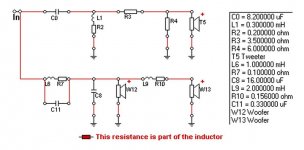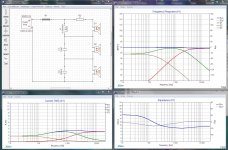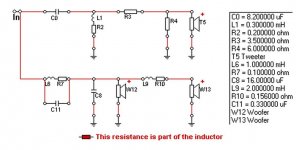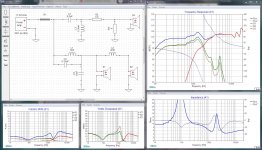 This thread has been split from - What amp should I be looking at for 4 ohm?
This thread has been split from - What amp should I be looking at for 4 ohm?****
Wow thankyou! Just the answer I was looking for!
My speakers share two 8ohm woofers in parallel.
Zaph|Audio - ZA5 Speaker Designs with ZA14W08 woofer and Vifa DQ25SC16-04 tweeter
I have the 5.3T.
The crossover is there too.
Would someone be able to guide me on how to go on about working the crossover for better impedance?
Last edited by a moderator:
Would someone be able to guide me on how to go on about working the crossover for better impedance?
I'm sure lots of us can ... but I think this should be moved to the Multi-Way speaker forum to continue.
To get us started, I've copied the crossover from the link you gave me and set up an XSim file for it. The XSim file does not have the exact driver specs, so I'm hoping you can fill this in for us.
The same will need to be done for each of your satellites as well.
The 5.3T appears to be a 2.5 way design where one of the woofers is reitired early (about 150 hz) which is interesting. Typical of this design the lowest impedance is in the deep bass region rising as the second woofer fades out but it also has a pretty deep dip just above the crossover point that may warrant some attention.
Hope this helps...
Attachments
Hi, I would not touch the speakers. It is very sharp and the risk is when the sound decreases in quality. You must be equipped with a microphone for measurements and a good knowledge of the design. It is not the choice of amplification in class D, but your is quite broad, in the sense that you need a preamp with processor for the multichannel processing of a CM. Then you can choose an amplifier like those based on IRS2092, they are generally very powerful and designed for low impedances
I'm sure lots of us can ... but I think this should be moved to the Multi-Way speaker forum to continue.
To get us started, I've copied the crossover from the link you gave me and set up an XSim file for it. The XSim file does not have the exact driver specs, so I'm hoping you can fill this in for us.
The same will need to be done for each of your satellites as well.
The 5.3T appears to be a 2.5 way design where one of the woofers is reitired early (about 150 hz) which is interesting. Typical of this design the lowest impedance is in the deep bass region rising as the second woofer fades out but it also has a pretty deep dip just above the crossover point that may warrant some attention.
Hope this helps...
EDIT: Sorry, I didn't notice you attached a file. I just installed xsim after trying to open your file, I don't know what you want me to fill in? I am sorry I am a total newbie at this!
Thankyou for your willingness to help!
All the driver specs are here!
http://www.zaphaudio.com/ZA14W08/ZA14W08-datasheet.pdf
If you could tell me what else you need, i'd take a look and get to you!
Hi, I would not touch the speakers. It is very sharp and the risk is when the sound decreases in quality. You must be equipped with a microphone for measurements and a good knowledge of the design. It is not the choice of amplification in class D, but your is quite broad, in the sense that you need a preamp with processor for the multichannel processing of a CM. Then you can choose an amplifier like those based on IRS2092, they are generally very powerful and designed for low impedances
I do have a UMIK-1 and I use REW for measurements.
What amp can be used just for stereo use that would best my AVR?
Last edited:
EDIT:
If you could tell me what else you need, i'd take a look and get to you!
There are two file types that XSim uses to analyse drivers... *.ZMA and *.FRD. I do not personally know how to compose those files from the info on the website but others may...
I do have a UMIK-1 and I use REW for measurements.
What amp can be used just for stereo use that would best my AVR?
That's easy ... The Crown XLS 1002 It's kind of a swiss army knife amplifier that has built in crossovers and can adapt to either pro or consumer levels very easily. The full details are on the Crown Audio website All you should need to do is plug this in to your front channel outputs and level match it with the rest of your system...
This would also take some of the load off the other channels, allowing Denon's power management to drive them more efficiently.
Last edited:
Hi, I would not touch the speakers.
I tend to agree ... It is a very technical area. But if the crossovers expose design deficiencies that are easily corrected, it is very unlikely sound quality would decrease and our friend's problem could be fixed with just a couple of parts replacements. Even if he goes to an outboard amplifier, he might still benefit from a crossover upgrade.
Ok I understand your point of view. But I don't think it's the best way to approach the problem. You have your opinion, I have mine. Looking forward to reading you. Thank you
To explain ...
I've seen, time and again, where crossovers are becoming more and more complex and less and less efficient ... and generally for no good reason. They've become my first suspicion when I hear things like "low dips in impedance" and "poor frequency response".
It's pretty unlikely that Denon is going to put out a deficient or poorly designed product... the returns and replacements would just kill them.
On the other hand the guy producing DIY speaker kits from his garage is far more likely to have problems in his designs simply because he has no R&D budget to speak of....
I went crossovers first because in our friends question it struck me as the most likely spot for a problem to be hiding. Crossover modelling is free, so no harm having a peek at that before the money starts flowing.
If I'm wrong it wouldn't be the first time...
EDIT: Sorry, I didn't notice you attached a file. I just installed xsim after trying to open your file, I don't know what you want me to fill in? I am sorry I am a total newbie at this!
Thankyou for your willingness to help!
I thought you might like to see what can be done with an alternative crossover design for your 2.5 way speakers.
Please note this is not a final design as I still can't locate the files for your specific drivers. This is an example using 3 8ohm "perfect" drivers that are the default in XSim ... please note the impedance curve never dips below 8 ohms.
Attachments
Last edited:
I thought you might like to see what can be done with an alternative crossover design for your 2.5 way speakers.
Please note this is not a final design as I still can't locate the files for your specific drivers. This is an example using 3 8ohm "perfect" drivers that are the default in XSim ... please note the impedance curve never dips below 8 ohms.
Thankyou so much for that Douglas!
So I am attaching a file for the tweeter, which is the Vifa DQ25. This file was found in this thread in partsexpress techtalk.
Seas CA18RNX & Vifa DQ25SC16 FRD Files... -
Techtalk Speaker Building, Audio, Video Discussion Forum
And for the Zaph files, I retraced the graphs! I hope I did it right!
Attachments
Thankyou so much for that Douglas!
So I am attaching a file for the tweeter, which is the Vifa DQ25. This file was found in this thread in partsexpress techtalk.
And for the Zaph files, I retraced the graphs! I hope I did it right!
I hope you got it right too ... The thumbnails and DXO are for the "stock" crossover with your files. Nothing is changed.
For the moderators ... you really should move this thread to the Multi-Way forum.
Attachments
Last edited:
I hope you got it right too ... The thumbnails and DXO are for the "stock" crossover with your files. Nothing is changed.
For the moderators ... you really should move this thread to the Multi-Way forum.
Seems like I traced the wrong graphs and it failed!
I have no idea what I did wrong
Thankyou for trying <3 !
Seems like I traced the wrong graphs and it failed!
I have no idea what I did wrong
Thankyou for trying <3 !
Naaa ... if we can get accurate ZMA and FRD files for your drivers we can easily continue ... but for now, I suggest you investigate an outboard amplifier for your Denon's front channels. The Crown XLS I recommended earlier would be a fine choice.
Would anyone happen to have ZMA and FRD file for the Zaph ZA5 driver?
http://zaphaudio.com/ZA14W08/ZA14W08-datasheet.pdf
I traced it but seems like I messed up somehow.
http://zaphaudio.com/ZA14W08/ZA14W08-datasheet.pdf
I traced it but seems like I messed up somehow.
Isn't there a 2 way version of this speaker published by ZAph?
Series wire the 2 basses and double coils and resistors in the bass crossover, halve capacitors etc. A TMM.
That will take midbass inpedance up hugely. Might fiddle with the tweeter crossover for higher resistance too.
Not much modelling needed.
Series wire the 2 basses and double coils and resistors in the bass crossover, halve capacitors etc. A TMM.
That will take midbass inpedance up hugely. Might fiddle with the tweeter crossover for higher resistance too.
Not much modelling needed.
Isn't there a 2 way version of this speaker published by ZAph?
Series wire the 2 basses and double coils and resistors in the bass crossover, halve capacitors etc. A TMM.
That will take midbass inpedance up hugely. Might fiddle with the tweeter crossover for higher resistance too.
Not much modelling needed.
They are 8 ohm drivers == 16 ohms in series == 6db drop in output, and that's going to sound very shrill.
Wiring them in parallel drops the impedance to 4 ohms, which is below the 6 ohm recommendation from Denon.
Last edited:
I know how it works! But why should an MT to series MMT conversion with the same drivers sound shrill? You just turn up the amp a bit. You won't improve the midbass impedance without series wiring of some sort.
I seem to get into deep water with Zaph designs, but really he gets very low impedance even on tweeters. That's because he uses an attenuator after the tweeter filter. Much better, IMO, to put some impedance raising resistance in front of the tweeter filter.
Makes for smaller values on components too.
You don't have to know anything about the drivers to do this conversion, except the DC resistance of the tweeter to remodel for higher tweeter impedance with the same acoustic slope in this case.
I seem to get into deep water with Zaph designs, but really he gets very low impedance even on tweeters. That's because he uses an attenuator after the tweeter filter. Much better, IMO, to put some impedance raising resistance in front of the tweeter filter.
Makes for smaller values on components too.
You don't have to know anything about the drivers to do this conversion, except the DC resistance of the tweeter to remodel for higher tweeter impedance with the same acoustic slope in this case.
It's easy enough to rectify.that's going to sound very shrill.
- Status
- This old topic is closed. If you want to reopen this topic, contact a moderator using the "Report Post" button.
- Home
- Loudspeakers
- Multi-Way
- Working the crossover for better impedance



